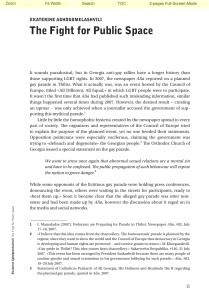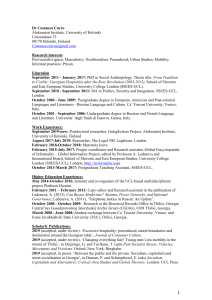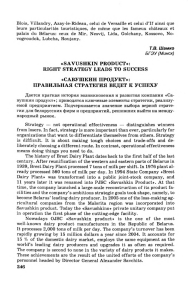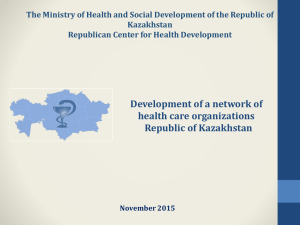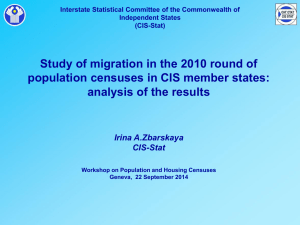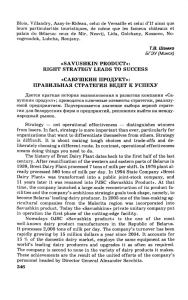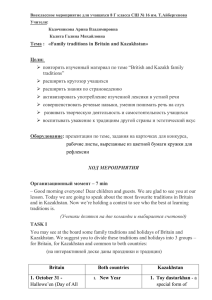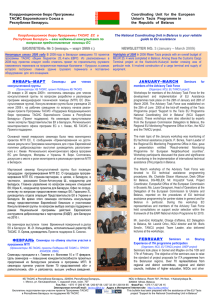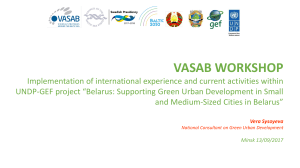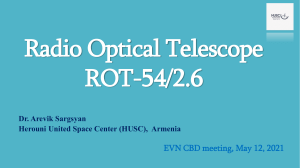министерство экономики и устоичивого развития грузии
реклама
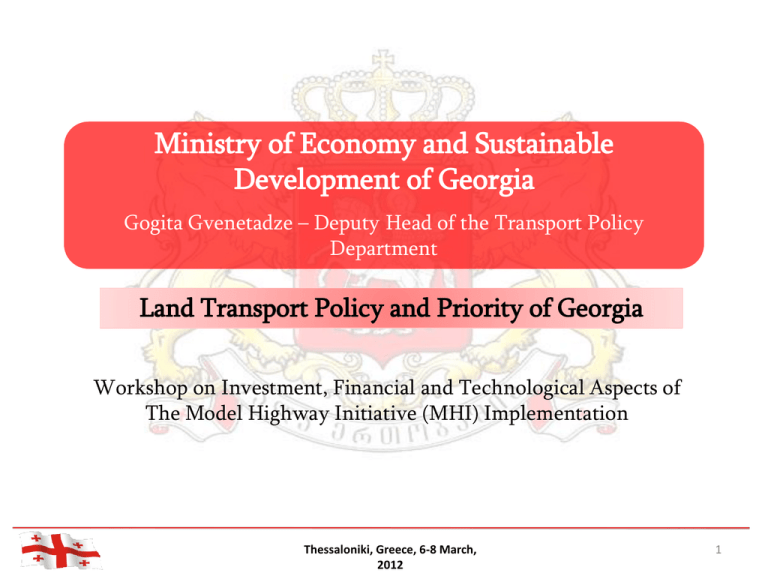
Ministry of Economy and Sustainable Development of Georgia Gogita Gvenetadze – Deputy Head of the Transport Policy Department МИНИСТЕРСТВО ЭКОНОМИКИ И УСТОИЧИВОГО РАЗВИТИЯ ГРУЗИИ Land Transport Policy and Priority of Georgia ДЕПАРТАМЕНТ ТРАНСПОРТНОЙ ПОЛИТИКИ Workshop on Investment, Financial and Technological Aspects of The Model Highway Initiative (MHI) Implementation Ra sexvedraa, misha daamate Thessaloniki, Greece, 6-8 March, 2012 1 Outlook • Country overview; • Transport priorities; • Transport reforms; • Key figures of transport; • The largest trade partners of Georgia; • Development of Transport Corridor (TRACECA); • Road Infrastructure; • Customs Reforms/BCP „Sarpi“; • Model Highway Initiative (MHI); • Free Industrial Zones in Georgia . Transport Policy Department 2 Country overview • Area: 69,700 sq km • Population (2010): 4.4mln • Life expectancy: 76 years • Official language: Georgian • Literacy: 100% • Capital: Tbilisi • Currency (code): Lari (GEL) • GDP 2010 (E): US$11.7 bln • GDP real growth rate 2010 (E): 6.4% • GDPCAGR ‘03-’10 (E) 4.9% • GDPper capita2010(PPP): US$5,057 • Inflation rate (e-o-p)2010: 11.2% • External Public debt to GDP 2010: 33.6% 2003 2010(E) • Nominal GDP (mln GEL) 8,564 20,791 • GDP per capita (GEL) 1,972 4,646 • Total budget revenues (mln GEL) 1,368 5,778 Transport Policy Department 3 Transport priorities • Integration of Georgia into international transport system and increasing of transit potential; • Active cooperation in the framework of TRACECA programme and future integration of Georgia into Trans-European Transport Networks (TEN-T); • Development of transport infrastructure links of regional significance with main roads; • Harmonization of legislation with international standards; • Development of a sustainable transport system through maximizing the use of existing infrastructure; • Elaboration of safety policy in the land transport field. Transport Policy Department 4 Reforms Ministry of Economy and Sustainable Development of Georgia – Policy-making power The United Transport Administration of Georgia under the Ministry of Economy and Sustainable Development was responsible for civil aviation, maritime and land transport in Georgia. On 15 April 2011 the Parliament of Georgia approved the relevant laws providing establishment of three legal Entities of Public Law – Civil Aviation Agency, Maritime Transport Agency and Land Transport Agency – that serve to technical regulating authorities of these fields and are under the umbrella of the Ministry of Economy and Sustainable Development of Georgia, whereas the elaboration of transport policy directions have been delegated to the transport policy department of the ministry. Structure of Transport Policy Department Transport Corridor Development Division Civil Aviation Division Land Transport Division Maritime Transport Division Main Functions of the department: • Elaboration of main directions of state policy; • Support of transit potential development; • Cooperation with international structures and organizations; • Elaboration of international agreements; • Participation in bilateral intergovernmental commissions; • Harmonization of Georgian legislation with international and European standards. Transport Policy Department 5 Key figures of transport Total Passenger Transportation Total Cargo Transportation 45.3 48.4 48.9 305.6 313.4 322.1 331.0 2008 2009 2010 2011 Mln. tons Mln. Passengers 49.0 2008 2009 2010 2011 Total Handled containers Total Handled Cargo by Ports 299,461 18.6 2008 2009 253,811 22.1 226,115 TEU/Unit Mln. tons 22.7 20.2 2010 2011 181,613 2008 Transport Policy Department 2009 2010 2011 6 The largest trade partners of Georgia Import to Georgia, thousand tons 2009 2008 Azerbaijan Turkey Ukraine Russia Armenia Brazil China Bulgaria Kazakhstan Ghana Italy Romania Iran UAE Germany Greece USA Belarus Switzerland Great Britain Other 854.3 774.1 684.0 501.1 481.8 135.7 132.3 132.1 103.3 75.4 74.7 71.6 61.8 56.8 54.9 53.3 41.6 38.3 32.6 27.7 304.0 Turkey Azerbaijan Ukraine Russia Armenia Romania Bulgaria Brazil Greece Turkmenistan China Switzerland Kazakhstan Germany Italy UAE Iran USA Belarus Great Britain Other 778.0 641.7 520.8 413.5 184.7 119.6 107.7 92.5 91.7 91.1 87.2 84.7 77.9 61.7 58.3 38.1 37.2 35.7 30.7 29.6 247.9 Turkey Ukraine Azerbaijan Russia Kazakhstan Singapore Bulgaria Romania China Armenia Greece Brazil Iran Italy Germania Turkmenistan Belarus Gabon UAE Switzerland Lithuania Other 2010 392.7 332.4 154.8 145.5 140.6 118.5 107.3 98.0 88.8 71.5 69.4 68.2 66.2 40.1 38.9 38.2 35.4 4.3 336.0 738.6Ukraine Turkey 655.8 643.6 Azerbaijan Russia Bulgaria Kazakhstan Armenia China Romania Ghana Brazil Germany Iran Italy Turkmenistan Australia Greece UAE Singapore Belarus USA Other 2011 783.3 648.3 587.7 384.6 237.3 209.9 171.8 150.6 125.1 112.7 101.5 82.7 71.8 70.5 49.5 48.2 47.6 36.1 36.0 28.2 23.0 322.0 Export from Georgia, thousand tons 2009 2008 Azerbaijan Armenia Turkey Ukraine USA Kazakhstan Mexico Romania Bulgaria Russia Canada Iran Italy LIthuania India Germany Belarus Netherlands UAE Other Unknown 774.6 130.9 121.7 114.1 47.0 27.5 26.6 15.6 14.4 14.1 13.5 12.9 10.9 10.6 10.5 7.7 6.0 3.1 3.1 37.0 305.2 Azerbaijan Turkey Armenia Ukraine USA Romania Italy Kazakhstan India Russia Iran Bulgaria LIthuania Albania Belarus Turkmenistan Germany UAE Japan Other Unknown 444.8 153.6 130.6 94.6 38.7 21.0 18.2 16.7 16.2 12.2 10.2 9.1 7.4 6.8 6.5 6.4 5.7 5.7 4.8 53.8 589.9 Azerbaijan USA Armenia China Ukraine Romania Turkey Kazakhstan India Russia Belarus Great Britain Italy LIthuania Iran Netherlands Germania Lebanon Egypt Bulgaria Turkmenistan Other Unknown 2010 186.2 143.4 138.8 133.5 96.8 63.0 32.9 26.9 16.9 13.7 13.2 12.3 12.1 9.3 8.8 8.5 8.3 8.3 7.8 7.5 6.9 54.9 Azerbaijan Armenia Ukraine USA Italy China Turkey Kazakhstan Mexico Romania Russia UAE Lebanon Iran Belarus Trinidad and Tobago India Lithuania Turkmenistan Netherlands Other Unknown 613.8 2011 403.9 126.9 96.9 83.4 54.7 49.2 48.8 36.4 23.1 22.7 19.2 18.4 14.1 13.1 12.3 11.6 9.7 8.1 6.1 5.5 49.1 569.4 Note: *data includes transported cargo by Railway and Truck Transport Policy Department 7 Road Transport Main figures International Truck Transportation (unit) Truck Transportation (Unit) Transit 143,279 126,304 102,574 Import 12 377 10% Export 12 338 8% 62 794 44% 61 548 41% 183,554 167,085 151,316 9 313 6% In 2011 transit figures through Georgia increased by 19% compared to 2010 In 2011 transportation figures in Georgia increased by 10% compared to 2010 Total 4 352 2% 7 022 4% 71 756 39% 69 721 42% 12 991 13% 46 863 46% 57 825 46% 42 720 41% 56 102 44% 71 172 50% 77 430 51% 90 342 54% 2006 2007 2008 2009 2010 107 446 59% 2011 Truck Transportation Tendency via Georgian Check Points (Unit) 2008 2009 Sarphi 85,496 Red bridge 46,240 Poti 36,847 Sadakhlo Batumi Lagodekhi Vale 28,686 6,858 5,297 3,120 Ninotsminda 756 Guguti 169 Other 982 2010 Sarphi 92,408 Red Bridge 56,048 Poti 39,151 Sadakhlo Lagodekhi 29,603 5,284 Vale 3,077 Batumi 1,666 Ninotsminda 1,266 Guguti Other 145 98 2011 Sarphi 97,084 Red Bridge 61,597 Poti 41,503 Sadakhlo 32,938 Sarphi 107,922 Read Bridge 73,129 Poti 46,103 Sadakhlo 32,126 Lagodekhi 7,184 Kazbegi 7,500 Kazvegi 4,859 Lagodekhi 8,083 Vale 4,755 Batumi 5,891 Batumi 4,742 Vale 5,026 Ninotsminda 4,575 Ninotsminda 1,965 Guguti 117 Guguti 408 Other 683 Other 237 Note: Data includes only loaded trucks Transport Policy Department 8 Development of Transport Corridor (TRACECA) Bearing in mind the geographical location of Georgia and the policy officially declared by the Government, Georgia aims: Serving as transit country; • Support of the regional projects for land, maritime and civil aviation transport; • To create hub for international carriage of the goods and passengers; • Identify problems hindering the development of trade and transport systems; • Promote TRACECA projects in aim to attract loans from IFIs and private investors; Georgia is a member of TRACECA since 1993 Transported cargo through TRACECA 85 Million tons • 50 2005 55 53 57 2006 2007 2008 Transport Policy Department 64 2009 2010 9 Road Infrastructure 89% of roads of international importance are in good condition; During last few years: 80 km’s of highway is constructed; International importance – 1’563 km Internal importance– 5’446 km Local importance– 13’426 km 3’000 km’s of roads are reconstructed; Investments – 1,2 billion USD; Total – 20’435 km Transport Policy Department 10 Road Transport Agreements Georgia has a bilateral Agreements with 21 states in the road transport field; Georgia is a party to the 12 main road transport multilateral Agreements and Conventions; Note: On the basis of the Decree of the president of Georgia #187 of 7.04.2011, Georgia acceded to the European Agreement concerning the Work of Crews of Vehicles engaged in International Road Transport (AETR). Transport Policy Department 11 Customs Reforms • Before 2005 import procedures required: • After 2009 import procedures require: 4 documents 54 documents Creation of Customs Clearance Zones in Tbilisi, Batumi, and Poti Transport Policy Department 12 BCP „Sarpi“ • 17 gates; • Infrastructure corresponding modern requirements; • Border control procedures conducted according to ,,Single window” (one shop stop) principle; • On the whole territory of BCP, luggage/hand baggage moved on special carts; • Opportunity to declaration in a simplified manner; • Checking done according to risk criteria; • Submit documents electronically (without using stamps and seals). Transport Policy Department 13 Model Highway Initiative (MHI) Model Highway Initiative (MHI)–Project ‘s main directions are: • Attraction of international investment for development of road infrastructure (modern auto stations, hotels, safe parking areas et.c.); • Harmonization of international experience based custom procedures; • Arrangement of international road border crossing points according to modern technique demands; Program results: • Development of middle and small businesses; • Creation of new working places; • Mite in national economics; • Fighting with corruption in borders and roads; • Acceleration of cargo transportation between Europe and Asia regions and reduction of their transportation cost. Transport Policy Department 14 Free Industrial Zones in Georgia Free industrial zone is the type of free zone envisaged by Customers Code of Georgia where the business-friendly regulations and favourable tax and customs system apply. FIZ is singled out during the limited time period for economical activity and the companies operating therein are subordinated to the special regime, which is more favorable from legal and commercial point of view. Poti FIZ – Rakia Georgia FIZ Kutaisi FIZ – Georgian International Holding RAKIA has signed a management concession with the Government of Georgia to develop a free and industrial zone near the existing Port of Poti; Poti Free Industrial Zone is the first in the south Caucasus region and it lies on the historic “silk route” linking the east to the west; 300 hectares of land around the port will be used for a state-of -art free industrial zone. More than 105 mln USD in 2009-2013 More than 10 000 employed people Development of industry, logistic parks, business centres 31 companies are already registered More than 20 000 employed people Development of industry Production is already exported in different countries Transport Policy Department 15 Thank your very much for your attention Gogita Gvenetadze Deputy Head of Transport Policy Department Ministry of Economy and Sustainable Development of Georgia Address: 12 Chanturia St. 0108 Tbilisi, Georgia Tel: + (995 32) 299 11 40 Mob: + (995 595) 960 350 E-mail: [email protected] www.economy.ge Transport Policy Department 16
